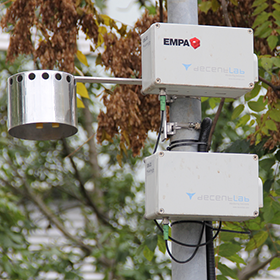Operation of low-cost air quality sensors
Sufficient selectivity and sensitivity to ambient air pollutants, compact design and low production costs are features of recently developed air quality sensors. These features facilitate their integration in sensor units and their use in sensor networks for comprehensive air pollution monitoring with high spatio-temporal resolution.
New concepts and algorithms have to be developed for operating air quality sensor networks intended to provide sufficiently accurate and reliable information and requiring minimum human interaction. Moreover, data on air pollutant concentrations originating from such networks have to be processed into information leading to an improved understanding of air quality, e.g. in urban environments.
Our interests in this field are focused on following subjects:
Air quality sensor network

- Characterization of the performance of available sensors
- Optimal integration of sensors into sensor units
- Sensor calibration
- Quality assurance and quality control (QA/AC) within sensor networks
- Network design
Data analysis and modelling
- Analysis of air pollution data
- Statistical modelling, i.e. combining air pollution sensor data with various geographic information
- Mapping of air pollutant concentrations

